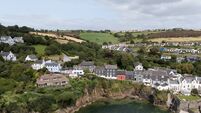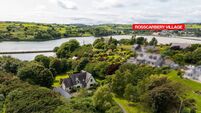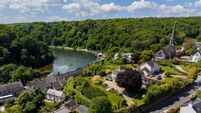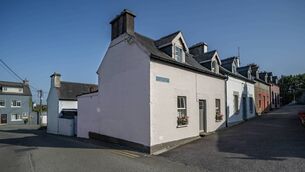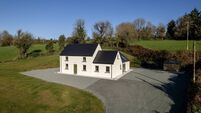Cover Story: Design done to a tee in West Cork’s Toe Head

There are still hidden places in West Cork, tiny peninsulas where through traffic is minimal and where locals form a close, but respectfully private group.
Toe Head is a bit like that — out of the main drag, (although it’s very close to Castletownshend) and full of quirky cul de sacs, hidden roads and huddled houses all within minutes of the sea. It’s a wild, windswept place in winter and warm and bright in summer when its collection of little white houses bask under a high sun.
Less rough and easier to handle than the other more westerly locations, this little headland is a collection of drumlins rising steeply towards the sea and then flattening out to a long and muddy shoreland which doesn’t entice the day trippers. Here and there there’s the odd good beach, but overall, the area seems to be used by locals only and that is why it’s the perfect bolthole for national and international buyers. You get remoteness and privacy, but in a well-serviced location and despite it’s off-the-beaten-track nature, there are plenty of neighbours to be had in Toe Head.
In one delightful corner of this place, there’s an old farmhouse that been completely renovated and extended, but not so you’d know it at first glance. Certainly, this blue and white vision that sits obliquely to the road looks very smart and well tended, but there’s very little changed of the original farmhouse, save for its white and Virgin Blue livery.
A simple wooden gate gives access to a wide, gravel forecourt which allows parking for lots of cars and/or boats while the extended roof line of the old house is the only hint that there’s a little bit more to the old dwelling than meets the eye.
You see, this property has been almost doubled at the rear, in a stand-apart, but attached, extension that respects and works with the house and its situation.
Simple and unfussy, this two-storey build is massive nonetheless and hugs the contours of the site, giving an interesting mix of levels in the interior.
And it’s not all about ‘the look’ either — simple workaday finishes mean this house can be locked up and left at short notice by its family owners. Because it’s a holiday home, serious consideration was given to space and comfort in the budget, rather than show or style.
And it’s why there’s plenty of room — 90 sq metres added on, with four bedrooms in total.
Entering the old house, there are traditional rooms east and west — the rooms have been opened out, somewhat, but the low ceilings and inglenook fireplace, along with an old clevy, are all still in place and this room is used as a snug on cold days, while the adjoining room is used as a home office/ study. The original front door is cleverly set behind two half doors, meaning the seal can be maintained in bad weather, (or when not in use) and on good days, the main door folds back, allowing the half doors to come into use, a very clever touch that allows the authenticity, but keeps a stock-proof barrier.
The rooms connect directly into the new living space, through double doors, in a space that would have been part of the old back door, (big beach stones keeps them ajar) and it’s the equivalent of walking from the 19th to the 21st century in one step.
Behind is a huge, kitchen/ dining/ living room following the sun path with dining room in the southerly end and a sitting area at the far west. The northern point gives access to a staircase spine and the kitchen is tucked into the north-easterly end of the building, facing over a back entrance.
The southern end has two banks of glazing, with a corner window on the western tip that’s a perfect viewing point, taking in the falling ground below it, the bay in the distance and the hills behind, almost like a painting. A simple stone fireplace, with stove, anchors the room.
The kitchen, in simple oak with granite top overlooks a small yard to the side, where an elaborate outside stairwell provides access to a store room and a utility room and leads into the internal staircase hallway. It runs down to a ground level, luxurious bathroom and bedroom and then upwards to the first floor where the new extension is tied into the old roof.
Gable windows on the new build maximise on southern light for the master bedroom, which has a double aspect and is simply finished in carpet, with Italian bedroom furniture that blends with the bespoke, joinery.
A second, boutique-hotel bathroom lies across the corridor and further up are two more bedrooms, part of the original house and complete with exposed beams and small windows facing south-east.
All the charm is intact and the furniture reflects the style, in contrast to the main bedrooms, which are sleek and unfussy and modern. The contrast is what makes this house, and it’s a credit to owners and architects that original features weren’t obliterated in the makeover: rather, they’ve been enhanced.
But the overall aesthetic is utilitarian — floors are tiled in high wear areas and fuss is kept to a minimum with simple oak dining room table and odd seating pieces in an arrangement that suggests the outdoors is to be enjoyed as much as life indoors.
Yet this house is not Spartan, far from it, the bedrooms and bathrooms see to that and modern heating and plumbing means plenty of heat and lashings of hot water in powerful jets. No, the emphasis here seems to be more on family, friends and fun, rather than preciousness. And that’s all to the good in a house that’s set to get a lot of use over the years.
Stephen Smith of Edge Architecture, and based in West Cork, headed up the project. And while a lot of architectural firms collapsed or moved emphasis to other countries during the recession, Edge, with its four directors, managed to hunker down and see the recession through, thanks mostly to extensions and one-off builds.
Currently, the Government is offering an incentive in tax relief for home improvements begun from the end of October last year and up to Dec 31 of 2015.
The work must cost over €4,405 and must be completed by a registered contractor and relief will be available over two years to a maximum of €30,000 or €4,050 in tax credits. More information is available on http://www.revenue.ie/en/tax/it/reliefs/hri/.
And perhaps, with a the combination of a warming economy, incentives for home-owners and the prospect of international lenders entering the mortgage market, work for building professionals will increase. In the meantime, architect’s body, the RIAI is opposed to working with new building regulations, due in March this year. Interesting times.






